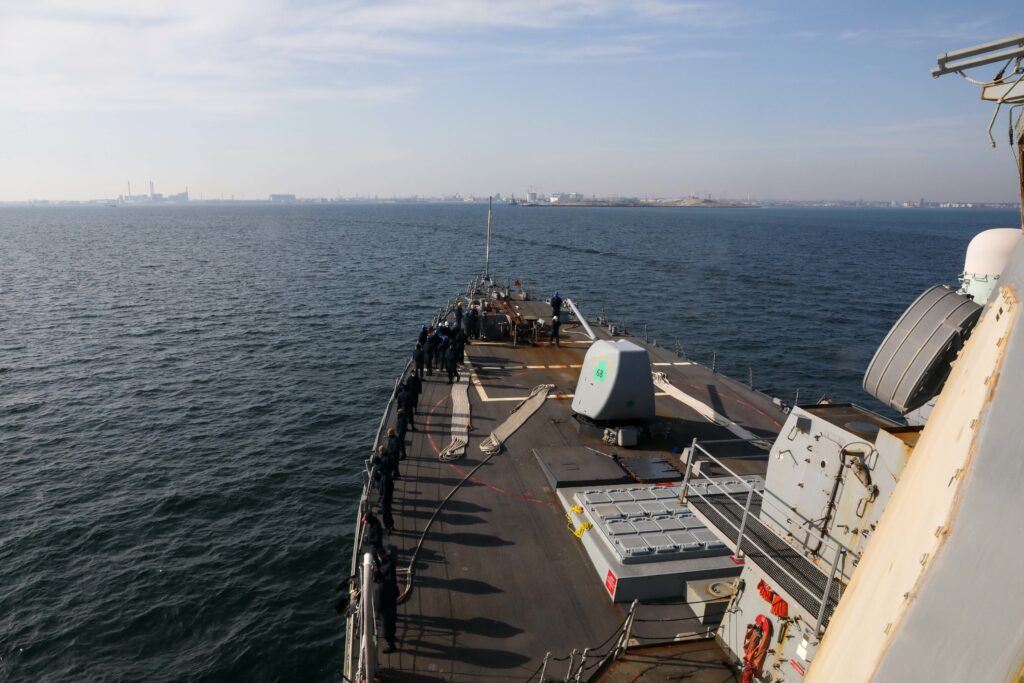
ARLINGTON, Va. — The recent surge of several guided-missile destroyers from the U.S East Coast to the North Atlantic Ocean and Baltic and North Seas was a successful demonstration of the flexibility of geographic command relationships and of the value with of the Optimized Fleet Response Plan, the commander of the U.S. Navy’s 2nd Fleet said.
Vice Adm. Daniel Dwyer, commander of U.S. 2nd Fleet, told reporters April 29 about the surge deployment of the destroyers under the operational control of Destroyer Squadron (DESRON) 22 support operations for the European Command and “to reaffirm our commitment to our NATO allies and partners.
“This historic task marked the first time since our re-establishment [in 2018] that U.S. 2nd Fleet provided command and control for forces operating in Europe, outside of an exercise,” Dwyer said.
Dwyer said his fleet showed the ability to “surge forces to provide the defense of Europe and to reassure our allies and partners of our commitment to the defense of the NATO alliance.”
The admiral declined to comment on whether the surge deployment from January to April 2022 was related to the Russian build-up and subsequent invasion of Ukraine.
The surging ships were the Arleigh Burke-class guided-missile destroyers USS The Sullivans (DDG 68), USS Donald Cook (DDG 75) the USS Forrest Sherman (DDG 98), and the USS Mitscher (DDG 57). Also attached was the command-and-control ship USS Mount Whitney (LCC 20), which normally serves as the flagship of the U.S. 6th Fleet in the Mediterranean Sea.
Dwyer said the surged DDGs were within the OFRP cycle, with each ship trained and certified.
“Some [DDGs] were at the beginning of their operational deployment cycle; some had just returned from an operational deployment and were in that sustained period which allowed me to use their certified and ready ships to meet mission,” he said. “Once we train and certify naval forces, we can deploy them right away as scheduled, or we can hold that readiness and deploy them later at time of need, or when they get back from a deployment and they are still trained, certified and ready in that sustainment phase if crisis occurs or need occurs. We can then deploy them and continue to leverage that training [and] certification and readiness. This shows that this OFRP cycle — the way it is built — allows us to move naval forces to the point of need and at the time of need with incredible agility.”
The fleet embarked DESRON 22 staff on one of the DDGs to act as the forward command element reporting back to the 2nd Fleet’s maritime operations center in Norfolk. When the USS Mount Whitney was assigned to the 2nd Fleet for the operation, the fleet was able to “use it to command and control forces in the North Atlantic with DESRON 22 embarked.” Dwyer said.
Operational Flexibility
The admiral stressed the operational flexibility of the number fleets to operate in different combatant commander areas of responsibility.
“Numbered fleet commanders are operational-level headquarters that can command and control naval forces at the point of need unconstrained by lines on a map,” he said. “This operation that we conducted showed that the 2nd fleet — [with the Western Atlantic up to the North Pole] — at time of need can surge forward to support a four-star naval headquarters with my maritime operations center commanding and controlling ships that are outside my normal area of responsibility.”
Dwyer said this operation was the first time the concept — with 2nd Fleet and 6th Fleet both supporting Naval Forces Europe — was put into practice.
“We showed and proved that unique, agile, mobile capability of a numbered fleet headquarters supporting another four-star naval headquarters, he said.
In an April 28 release, the 2nd Fleet said the ships operated with maritime forces from Denmark, France, Germany, Italy, The Netherlands, Poland, Sweden, and the United Kingdom.






